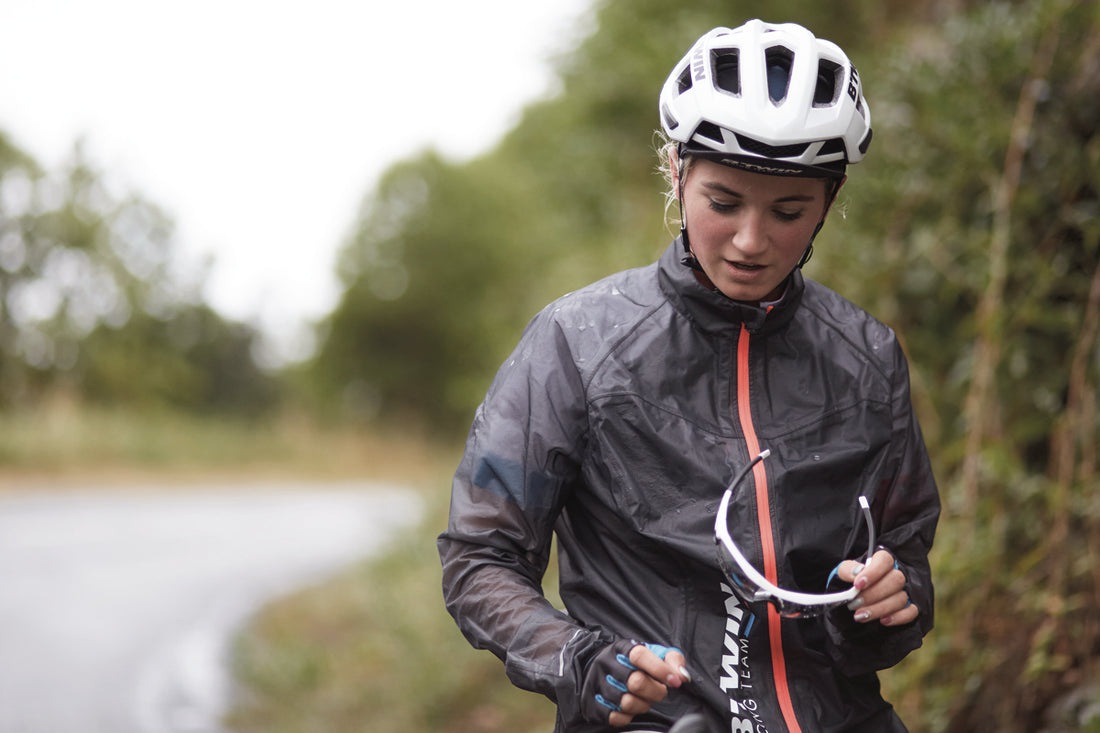
9 Tips for Riding in the Rain
Share
Riding in the rain may not be our top choice. Sometimes, though, we don’t have an option, and sometimes, it’s better than staying at home. Preparation, the right gear and proper clean-up after can make a rainy-day ride tolerable. You might even enjoy it! Here are our top tips for riding in the rain:
1) Let it rain.
When it first starts raining, the roads are extra-slippery. Wait until it’s been raining for a full day or two before heading out on the roads (if possible). This allows grease and grit to wash off the pavement. If you do get caught in the rain, use extra caution, especially when cornering and descending.
2) Keep your hands, feet and core warm.
Nobody wants frozen hands and feet on a ride. Shoe covers can not only keep your feet warm (and drier), but they also help keep your shoes clean. Keeping your fingers warm with the right gloves can make your ride far more pleasant, as well. (Find some glove options here.) If you’re riding for longer, it can be nice to bring a second pair of gloves in a ziplock bag to swap out mid-ride.
Pro tip: Dry out your shoes after a wet ride by removing the shoe inserts and stuffing the shoes with wadded-up newspaper. Line the shoes up near a vent or heater, where they’ll get a little extra air flow.
Wearing a vest and/or base layer will help keep your core warm, making the rain much more comfortable.
3) Wear rain gear.
The right clothing, from the top of your head to the bottom of your feet, can make all the difference in rainy weather. This includes a proper rain jacket, whether it’s a lined, warmer jacket for cold conditions or a more breathable one for less extreme temperatures. Unless it’s waterproof, thicker clothing will just get heavy and waterlogged when you’re riding in the rain.
Covering your legs can be good, too, in order to keep your joints warmer against the wind. If you’re bike-commuting, these overpants can protect your street clothes from the elements. And, of course, don’t forget a balaclava to keep your neck warm.
4) Get visible.
Rainy weather means diminished visibility on the road. Make sure other vehicles can see you by choosing high-visibility clothing and adding front and rear lights to your ride. (Yes, even in the daytime.)
5) Waterproof your stuff.
Waterproof backpacks, saddle bags and panniers can help keep your gear clean and dry when it starts to rain. You can also use a waterproof case to keep your phone and other valuables from getting wet. These cases are handy to have around in all conditions. (Nobody likes a sweaty phone, either.)
6) Rain-proof your bike.
A fender can prevent the “rooster tail” from shooting your backside with muddy water. Check out these options to attach to your bike when it starts raining. The person riding behind you will thank you for this addition as well.
If you’re planning on riding in the rain, use a thicker chain lube designed for wet and muddy conditions. This will protect your chain from rust and keep it running smoothly. Make sure you apply the chain lube when the bike is dry.
Leaving your bike outside in the rain? Cover your saddle with a plastic bag or use a waterproof saddle cover.
7) Pack an extra tube and CO2.
Rain can wash up road grit and glass, and leave other sharp objects on the edges of the road and in the bike lanes. This can increase the likelihood of a puncture. Make sure you have all the proper flat-fixing gear with you, and maybe an extra CO2 and tube. Added option: A waterproof saddle bag can keep your tools from getting wet and rusty.
8) Use extra caution.
As you know, rain makes the roads more slippery, particularly on painted lines and slick surfaces such as manhole covers and railroad tracks. Hold a straight line when riding over the painted sections, if possible. Give yourself extra room to brake, as rain reduces the performance of your brakes (especially rim brakes). Avoid deep puddles, or, if you must ride through them, slow down to account for obstacles that may not be visible under the water. And, of course, be sure to give other vehicles on the road plenty of signal. It’s harder for drivers to see and maneuver in the rain, too!
9) Clean your bike and re-apply chain lube.
After the ride is done, make sure to clean your bike right away, as the grit and mud from the road can cause corrosion. Rinse off and wipe down your bike right away and remember to add chain lube when the bike is dry.
Happy riding (even in the rain)!















